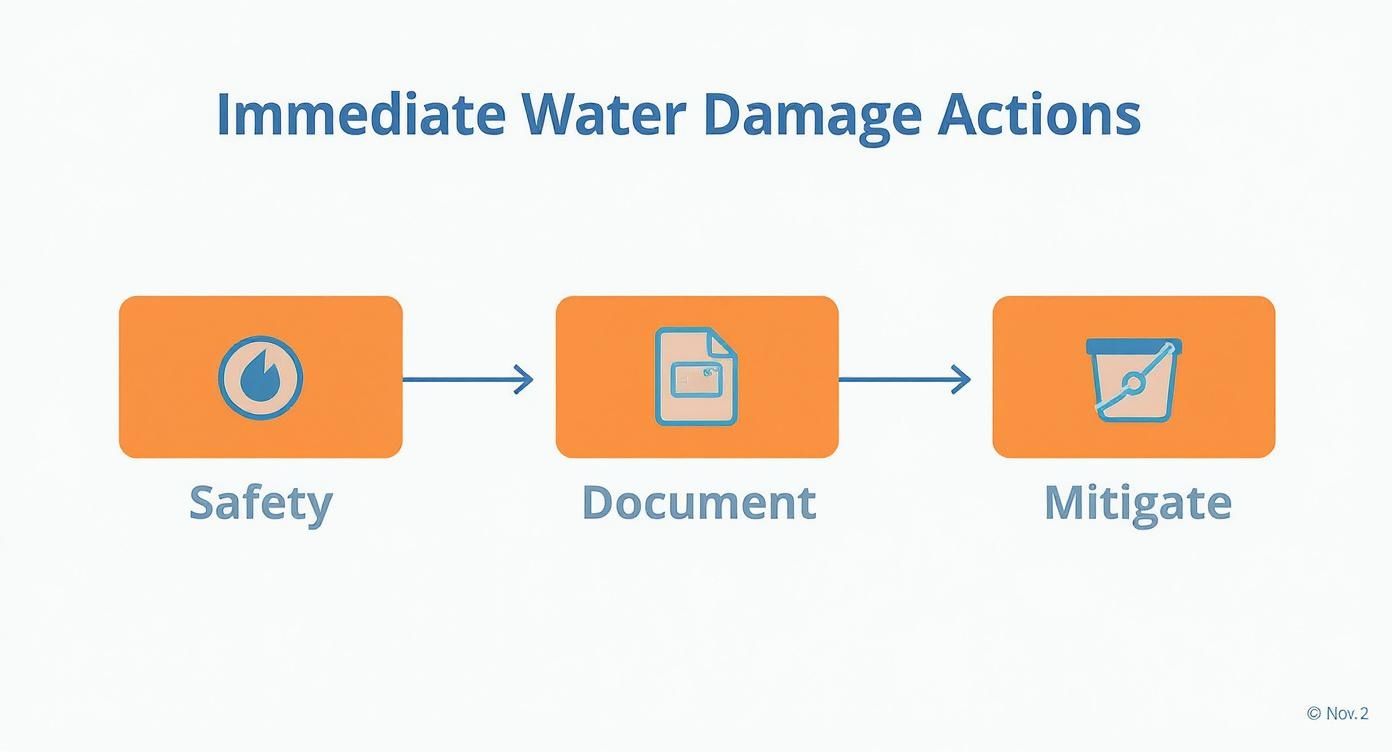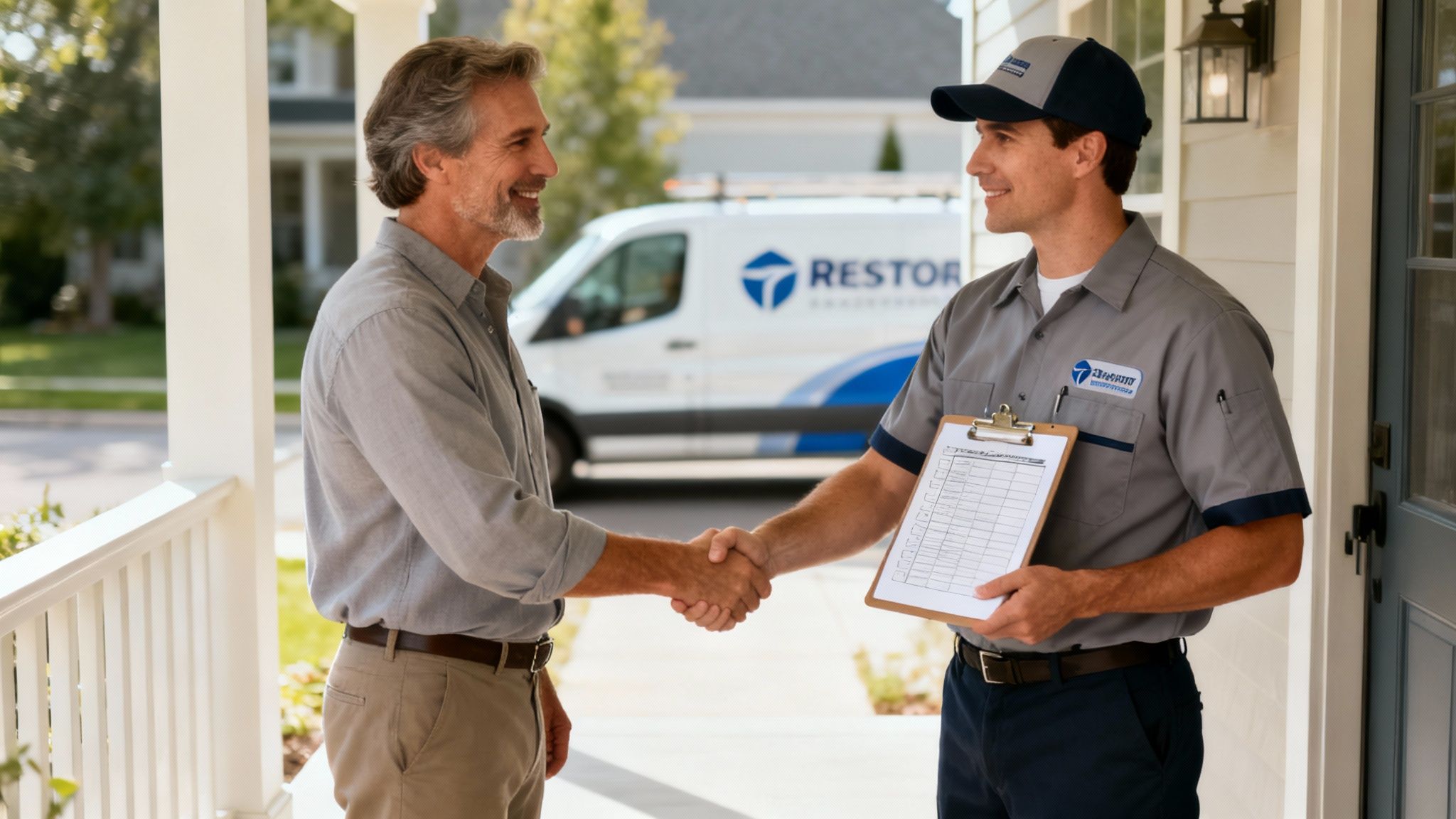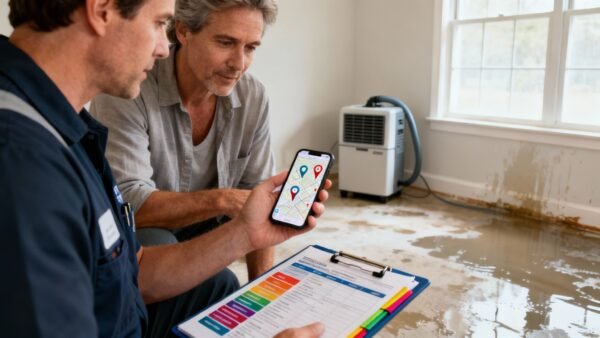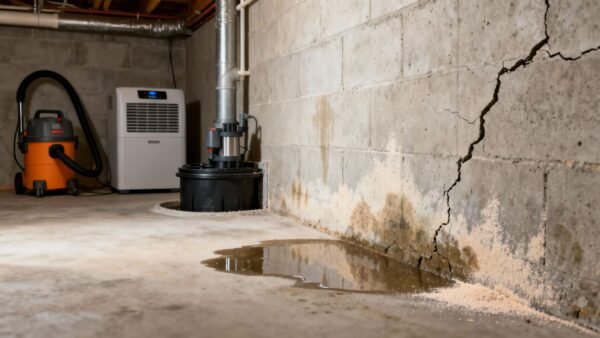Finding a leak, flood, or any standing water in your home is always a shock. Those first few hours are absolutely critical—what you do right away can dramatically reduce the final repair bill, the damage, and the overall stress while you search for restoration water damage companies near me. In the first 100 words, it's essential to understand that before the pros arrive, your only job is to focus on safety and preventing things from getting worse, whether you're dealing with a flat-roof leak in Sherman Oaks or a burst pipe in a Beverly Hills condo.
Don't let water damage sit and get worse. The expert team at Onsite Pro Restoration is on call 24/7 to provide a free assessment and get the recovery process started immediately.
Call (818) 336-1800 for an Immediate Response
What To Do Immediately After Finding Water Damage
The moments after you spot water damage feel chaotic, but having a clear plan can stop a bad situation from spiraling into a full-blown catastrophe. Your top priorities are simple: make sure everyone is safe, shut off the water source, and get detailed proof for your insurance claim. Acting fast and with purpose sets the stage for a much smoother and more effective professional restoration.
Prioritize Safety Above All Else
In any water-related emergency, the single biggest danger is electrocution. Water and electricity are a deadly mix, so don't take any chances.
- Shut Off the Power: If you can safely get to your main circuit breaker, kill the power to all the wet areas. If you have to step through standing water to reach the panel, do not attempt it.
- Stop the Water Source: If you're dealing with a burst pipe or an overflowing appliance, find your home's main water valve and shut it off. This immediately stops the flow and contains the problem.
Document Everything for Insurance
Before you touch a single thing, pull out your smartphone and document the damage. This evidence is the foundation of your insurance claim, so be thorough.
Take plenty of photos and videos showing the standing water, soggy drywall, soaked furniture, and any personal belongings that got wet. Get shots from different angles to create a complete picture of the damage. This step is absolutely essential for proving the full extent of your loss to the insurance company.
For a deeper dive into these initial steps, our guide on emergency water cleanup has more crucial tips you'll want to know.
When you first find water damage, it’s easy to feel overwhelmed. This simple checklist helps you focus on the most important actions to take in the first 30 minutes.
Emergency Water Damage Checklist
| Priority | Action Item | Reason |
|---|---|---|
| 1. Safety First | Shut off electricity to affected areas (if safe to do so). | Prevents the immediate and lethal risk of electrocution. |
| 2. Stop the Source | Locate and turn off the main water shutoff valve. | Stops more water from entering and causing further damage. |
| 3. Document | Take photos and videos of everything before moving it. | Creates crucial evidence for a successful insurance claim. |
| 4. Call for Help | Contact a 24/7 water damage restoration professional. | The sooner they arrive, the less secondary damage (like mold) occurs. |
| 5. Notify Insurance | Call your insurance agent to report the loss and get a claim number. | Starts the official claims process and confirms your coverage. |
Following these steps methodically will protect both your family and your property, giving you a solid foundation for the professional restoration to come.
The Professional Water Damage Restoration Process Explained
So you’ve made the call to a local restoration company. Now what? Knowing what the pros do when they arrive can take a lot of the stress out of the situation and give you a clear idea of what to expect. Their goal isn’t just to get the water out; it’s to bring your home back to its safe, dry, pre-damage condition.
This isn’t just a glorified mopping job. It’s a scientific process of drying, sanitizing, and repairing your property. Every step is designed to head off bigger problems down the road, like structural rot and dangerous mold, which can start growing in as little as 24 to 48 hours.
Step 1: Inspection And Damage Assessment
The very first thing a certified technician will do is a full-scale inspection. They're not just looking at the puddles you can see. Using professional tools like moisture meters and thermal imaging cameras, they'll pinpoint the full extent of the damage, including moisture hiding behind your walls or under the floorboards.
From there, they’ll classify the water source into one of three categories:
- Category 1 (Clean Water): This comes from a sanitary source, like a broken water supply line.
- Category 2 (Gray Water): This water is contaminated to some degree. Think of an overflow from a washing machine or dishwasher.
- Category 3 (Black Water): This is highly contaminated water from sources like sewage backups or floodwaters, and it poses serious health risks.
This classification is crucial because it determines the exact safety protocols and restoration methods needed to handle the job correctly.
While you're waiting for the team to arrive, there are a few things you can do. This infographic breaks down the immediate actions that can make a huge difference.

As you can see, safety, documentation, and some initial mitigation steps are the foundation of a solid emergency response.
Step 2: Water Removal And Extraction
Once the assessment is done, the crew gets to work on removing all standing water. This means bringing in the heavy-duty equipment—powerful, truck-mounted vacuums and submersible pumps that can extract thousands of gallons of water in a hurry. Getting the bulk water out fast is key to minimizing further damage and cutting down the drying time.
For a deeper dive into the entire workflow, check out our complete guide to the water damage restoration process.
After the main extraction, technicians use specialized tools to pull water from carpets and padding. This is a vital step that prevents secondary damage and gets the space ready for the all-important drying phase.
How To Choose The Best Local Restoration Company
Let's be honest—not all restoration companies are created equal. When your home is flooding, the instinct is to hire the first company that picks up the phone. But taking a few minutes to do some quick homework can save you from a massive headache down the line.
The goal is to find a genuine partner, someone with the right credentials, proven experience, and a solid reputation.

This decision is a big one. You're trusting a team with your property's safety and your family's health. You need someone who will get the job done right the first time, heading off secondary problems like hidden mold growth and structural decay before they even start.
Essential Credentials To Verify
Before any work begins, you need to confirm they have the right qualifications. These are non-negotiable—they protect you from liability and shoddy work.
- Licensing and Insurance: Make sure the company is fully licensed to operate in California and carries both general liability and worker's compensation insurance. This is your shield if a worker gets injured on your property.
- IICRC Certification: The Institute of Inspection, Cleaning and Restoration Certification (IICRC) is the gold standard in our industry. A certified firm has technicians who have proven they understand the science behind proper, effective restoration.
The global water damage restoration market is booming, projected to fly past $40 billion by 2033. All that growth means more companies are jumping into the business, which makes it even more critical for you to verify credentials and steer clear of inexperienced crews.
Key Questions To Ask Potential Companies
Once you’ve confirmed their credentials, it’s time to dig a little deeper. Knowing the essential questions to ask contractors before you sign anything is one of the most powerful tools you have.
A reputable company won't just answer your questions; they'll welcome them and give you clear, direct answers.
Here’s a quick checklist of what to ask:
- Response Time: How quickly can you have a team on my property? In an emergency, you're looking for a response within 60-90 minutes.
- Experience: How long have you been in business? More importantly, have you handled situations exactly like mine before in the Los Angeles area?
- Insurance Process: Do you work directly with insurance companies? A "yes" here can dramatically streamline your claim.
- Documentation: What kind of documentation do you provide for the insurance claim? They should offer detailed reports, photos, and daily moisture readings.
- Equipment: What kind of equipment do you use? Look for them to mention industrial-grade dehumidifiers, high-velocity air movers, and professional moisture meters.
Finally, do a quick check of their local reputation. Read recent online reviews and look for patterns—good or bad—related to their communication, professionalism, and the final quality of their work. Choosing the right partner from the start is the single most important step in becoming a successful restoration pro in your own recovery effort.
Understanding The Cost Of Water Damage Restoration in Los Angeles
When you’re facing a water emergency, one of the first questions is always, "How much is this going to cost?" The final bill isn't just one arbitrary number; it's a sum of several critical parts that a restoration pro assesses during their initial walk-through. If you understand these variables, you’ll be able to read an estimate with confidence and know if you're getting a fair price.
The biggest drivers behind the cost are how widespread the damage is, what kind of water is involved, and which materials got wet. A simple leak from a clean water line that’s contained in one room is a completely different ballgame than a major flood involving contaminated water that has soaked into your drywall, insulation, and hardwood floors.
Key Factors That Influence Your Final Bill
No two water damage jobs are exactly alike, but the costs are consistently driven by the same core elements. Here’s what restoration water damage companies near me look at when building your quote:
- Size of the Affected Area: This is a big one. The total square footage of the damaged area is a primary cost driver because a larger space demands more labor, more equipment, and more time to dry everything out properly.
- Category of Water: Professionals classify water into three categories based on contamination levels. Category 1 (Clean Water) is the least expensive to handle. On the other end of the spectrum is Category 3 (Black Water), which contains sewage or floodwater and requires intensive sanitization, making it the most expensive to mitigate.
- Materials Affected: It’s a lot harder to restore porous materials like carpet, drywall, and insulation than it is to dry out a concrete slab. Hardwood floors, for example, are particularly tricky and often require specialized drying equipment—or even full replacement—which can significantly bump up the budget.
- Length of Time: The clock is your enemy here. The longer water sits, the more damage it causes. A fast response minimizes how much everything soaks in and helps prevent secondary problems like mold, which ultimately keeps your costs down.
Nationally, the price tag for water damage restoration can vary quite a bit, but the average project lands somewhere around $3,849. That number reflects the need for specialized equipment, skilled technicians, and any materials that need to be replaced. For another perspective, the experts at Angi.com also track how restoration costs are calculated.
For a more granular look at where that money goes, our comprehensive guide on water damage cleanup cost breaks down the numbers even further.
Why Mold Growth Is A Serious Risk After Water Damage
Once the immediate crisis of a flood or burst pipe is over, a much quieter—and often more dangerous—threat begins to creep in. Water damage creates the perfect breeding ground for mold, which can start colonizing damp materials like drywall, carpet, and wood in as little as 24 to 48 hours, especially in coastal areas like Santa Monica where fog and humidity are common.

That incredibly short timeline is why a proper response isn’t just about drying things out; it’s a race against the clock to prevent a secondary disaster. Mold isn't just an ugly stain. It releases microscopic spores into the air that can cause serious health problems, particularly for kids, the elderly, and anyone with existing respiratory issues.
The Health Risks Of Hidden Mold
Exposure to indoor mold can set off a whole host of health problems, from what feels like a never-ending allergy season to more severe respiratory infections. The tricky part is that the symptoms often look just like a common cold or flu, making it tough to connect the dots.
Common health issues linked to mold exposure include:
- Chronic coughing and wheezing
- Itchy eyes, skin irritation, and rashes
- Persistent headaches and fatigue
- Worsening of asthma symptoms
Because the stakes are so high, professional mold remediation is a non-negotiable part of any complete restoration job. For a clearer picture of the problem, it's worth understanding the importance of professional mold testing. Our team is also equipped to provide comprehensive LA mold testing to identify any hidden threats inside your property.
The numbers back this up. In the U.S., water damage restoration makes up nearly 50% of the industry's $15 billion annual revenue, and mold remediation adds another 20%. This shows just how intertwined these two issues are and why finding restoration water damage companies near me certified in both disciplines is critical for a safe, complete recovery.
How To Navigate Your Insurance Claim For Water Damage
Let's be honest: dealing with an insurance claim can be the most headache-inducing part of recovering from water damage. The key to a smooth process is knowing what your policy actually covers—and just as importantly, what it doesn't.
Most standard homeowner's policies are designed for sudden and accidental events. Think a burst pipe flooding the kitchen or a washing machine hose that gives out without warning. What they almost never cover is damage from slow, gradual leaks or overland flooding from a storm. For that, you’d need a completely separate flood insurance policy from an entity like FEMA.
Once you’ve made sure the area is safe, your very first call should be to your insurance agent. Get that claim number and find out exactly what they need from you to get the ball rolling.
Working With Your Restoration Company And Adjuster
This is where hiring the right professionals makes all the difference. Reputable restoration companies are experts at navigating the insurance maze because they deal with it every single day. They speak the same language as adjusters and use industry-standard software to build the detailed, itemized estimates that carriers expect to see.
This direct line of communication is a huge plus for you. Your restoration team will handle the heavy lifting:
- Create exhaustive documentation, complete with photos, moisture readings, and a precise scope of work.
- Communicate directly with your insurance adjuster to justify every necessary step and its associated cost.
- Help push the approval process forward so work can begin without frustrating delays.
Remember, your restoration company works for you, not the insurance company. Their role is to advocate for the complete and proper restoration of your property, ensuring no corners are cut.
This partnership is critical to getting your claim approved quickly and your home restored the right way the first time.
Frequently Asked Questions About Water Damage Restoration
When you’re facing a water emergency, your mind is racing with questions. We get it. Here are the answers to some of the most common things our clients ask when they're searching for restoration water damage companies near me.
Q: How long does the restoration process take?
A: There's no one-size-fits-all answer—it really depends on how bad the damage is. A small, contained leak in a single room might be wrapped up in a couple of days. But for a major event, like a flooded basement, you could be looking at a week or even longer. The longest part of the job is almost always the structural drying. That phase alone typically takes 3 to 5 days of running specialized equipment around the clock. This ensures we pull every bit of hidden moisture from materials like your drywall and wood framing. After their initial assessment, any good restoration team will give you a clear, realistic timeline.
Q: Can I just dry the area myself with fans?
A: Using a few box fans seems like a smart first move, but honestly, it’s not nearly enough to prevent serious long-term problems. Household fans just push surface-level air around; they can't touch the deep, trapped moisture that has already soaked into subfloors, insulation, and the cavities inside your walls. Professional restoration uses industrial-grade air movers, commercial dehumidifiers, and moisture detection tools to find hidden water and confirm when materials are actually bone-dry. Trying to do it yourself without this equipment is a huge gamble on hidden mold growth and structural rot.
Q: Will my homeowners insurance cover water damage?
A: For the most part, yes, but with one big condition: the damage must be from a sudden and accidental event. Think of a burst pipe, a ruptured washing machine hose, or a failed water heater—those are almost always covered. Where you run into trouble is with gradual damage, like a slow drip from a pipe you knew about but didn't fix. Standard policies also exclude overland flooding from storms or rising rivers; that requires a completely separate flood insurance policy. The best first step is always to call your insurance agent right away to verify your coverage.
Q: How much does professional water damage restoration cost in Los Angeles?
A: The cost varies widely based on the size of the area, the type of water (clean vs. contaminated), and the materials affected. While national averages hover around $3,849, a project in Los Angeles can be influenced by local labor rates and disposal fees. A minor cleanup might be a few hundred dollars, while a large-scale flood involving multiple rooms and hazardous "black water" could cost $10,000 or more. The only way to know for sure is to get a detailed, on-site estimate from a certified professional.
Don't let water damage sit and get worse. The expert team at Onsite Pro Restoration is on call 24/7 to provide a free assessment and get the recovery process started immediately.





